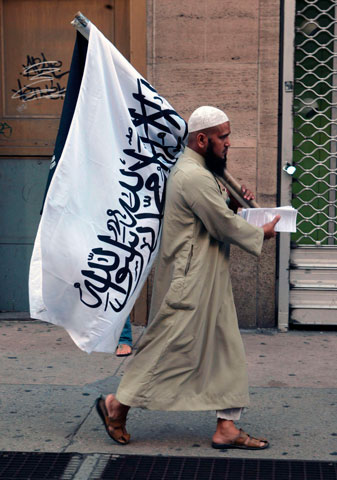
On Sept. 11, 2010, a Muslim man holds out literature to people at protests over the construction of a Muslim community center in Manhattan, N.Y. (Newscom/SIPA/Terrence Jennings)
 THE NEW RELIGIOUS INTOLERANCE: OVERCOMING THE POLITICS OF FEAR IN AN ANXIOUS AGE
THE NEW RELIGIOUS INTOLERANCE: OVERCOMING THE POLITICS OF FEAR IN AN ANXIOUS AGE
By Martha C. Nussbaum
Published by Belknap Press, $26.95
Intolerance appears to be in vogue. From 2012-13 congressional intransigence to the horrifying spate of recent mass shootings, Americans appear to be less willing to compromise and more likely to act on their fears. Worse, they convince others to share those fears.
In this climate, Martha Nussbaum’s The New Religious Intolerance is a welcome antidote. Her examination of contemporary religious intolerance reveals a strong command of the facts of each case that she cites, and her examples range from Aristotle to “The Invasion of the Body Snatchers.” She is the Ernst Freund Distinguished Service Professor of Law and Ethics at the University of Chicago, and her books apply her deep learning in ancient Greek philosophy to such issues as social justice, disability, and animal rights. Interestingly, she refers to her own upbringing and religious conversion to illustrate instances of religious intolerance. Though Nussbaum’s self-revelations at first discomfit, ultimately her candor enriches her discourse.
Nussbaum argues that we need the fear impulse to survive; too often, however, our fears lead us to misunderstand and even persecute religious minorities. No doubt, she writes, real issues like economic insecurity or rapid social change generate legitimate anxieties. However, Nussbaum shows us how demagogues exacerbate this anxiety. They displace the fears generated by actual problems onto minority groups of whom the majority has been historically suspicious.
Further, political opportunists and their media supporters aggravate these fears by suggesting that the harmless mien of suspected minorities disguises a malevolent intent. Continually pounding away at these “suspect” minorities, extremist pundits and bloggers exaggerate perceived threats and thereby magnify their relative urgency -- a process that Nussbaum labels the “availability heuristic.” With the threat published so widely, many jump on the bandwagon of fear and isolate the threatening minority (and thereby themselves): Burqas are banned, headscarves forbidden, and minarets -- even kebab shops -- are denied permits.
Nussbaum characterizes these majority fears as “narcissistic” -- in that fear is “focused on the self and the safety of the self.” In this manner, fear “threatens or prevents love.” Only through an “examined life” can we manage our fears, so Nussbaum offers a three-pronged solution:
- We must embrace the premise that all humans possess equal dignity, and that governments must respect that dignity and not consider it to be contingent upon certain conditions. Firmly connected is respect for conscience, especially the conscientious freedom to exercise one’s religious belief without fear of reprisal.
- Because our narcissistic fears prevent us from respecting the positions or persons of others as we hope to be respected (and, conversely, excuse us from the same standards that we impose upon others), we must actively root out inconsistencies in our reasoning from principles. How, Nussbaum wonders, we can decry a Muslim community center in Lower Manhattan while we countenance strip clubs and an off-track betting site in the same neighborhood?
- In order to see all people as dignified humans, despite our fears, we must exercise a sympathetic imagination and cultivate “inner eyes” that take the feared other’s perspective. By doing so, we can understand, if not agree with, the goals of the other and imaginatively participate in, instead of persecute, the lives and world that their consciences dictate. An important means by which we can cultivate this sympathetic imagination, Nussbaum argues, is through reading, especially those texts that compel us to identify with those about whom we know little and thereby fear. She makes a strong case that Gotthold Ephraim Lessing’s Nathan the Wise, George Eliot’s Daniel Deronda and the children’s books of Marguerite de Angeli should be on any ethically minded high school or college instructor’s reading list.
Her subsequent extensive study of Park51, the Manhattan Muslim community center, faults the narrow-mindedness and fear tactics of Newt Gingrich and some FOX News pundits, chides the ineffectual and somewhat ambiguous response of President Barack Obama, and lauds the accommodationist rhetoric of Mayor Michael Bloomberg, who has called for New Yorkers and others to exercise a logical consistency in considering the rights of minority religions.
If the author promotes a single hero, it is the 17th-century Protestant theologian and Rhode Island founder Roger Williams. To Nussbaum, Williams is the paragon of religious toleration: He argued for the accommodation of all conscientious groups, including nonbelievers; he attacked the colonial governors for their inconsistent application of principles of liberty of conscience; and, in his effort to cultivate sympathy with the Narragansett Indians, he wrote a book of instructions for respectful dealings with these Native Americans that includes a primer on the Narragansett language. For Nussbaum, Williams sets an example of a principled self-examination that can enable us to manage our fears.
Through its powerful examples and principled approach to creating an atmosphere of mutual respect, The New Religious Intolerance is required reading for fearful times.
[Dennis D. McDaniel is associate professor and chair of the English department at St. Vincent College in Latrobe, Pa.]

